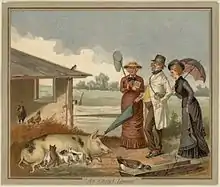Object lesson
An object lesson is a teaching method that consists of using a physical object or visual aid as a discussion piece for a lesson. Object lesson teaching assumes that material things have the potential to convey information.[1]
| Look up object lesson in Wiktionary, the free dictionary. |

Description
The object lesson approach is promoted in the educational philosophy of Johann Heinrich Pestalozzi, who held that teaching should begin with observation of objects which help students recognize concepts.[2] In his teaching and writing he emphasized the concept of Anschauung, which may be understood as “sense training.” Pestalozzi taught that children were first to develop sensation, then perception, notion, and finally volition, learning how to act morally based on an individual view of the world.[1]
History
Object lessons were important elements in teaching during the Victorian era of the mid- to late-nineteenth century.[3] By the early twentieth century they were widely used in religious instruction.[4] The popular Baptist educator, Rev. Clarence H. Woolston wrote a number of books about using everyday objects to aid instruction, including Seeing Truth: A Book of Object Lessons with Magical and Mechanical Effects, Penny Object Lessons: 25 Lessons for 25 Cents, and The Bible Object Book: A Book of Object Lessons Which Are Different, Written in Plain English and in Common Words.[5]
References
- Carter, Sarah Anne (2010). "On an Object Lesson, or Don't Eat the Evidence". The Journal of the History of Childhood and Youth. 3 (1): 7–12. doi:10.1353/hcy.0.0081 – via Project MUSE.
- MAKINAE, Naomichi. 2010. "The Origin of Lesson Study in Japan." Paper presented at EARCOME5, Japan Society of Mathematical Education
- "Object lessons" HPS Museum Blog (at the University of Leeds), 5 December 2012 (accessed 16 March 2013)
- Hasinoff, E. L. (2011). Object Lessons. In: Faith in Objects. Contemporary Anthropology of Religion. New York: Palgrave Macmillan. p. 71. ISBN 978-1-349-29733-7.
- "WorldCat.org". WorldCat.org. Retrieved November 25, 2019.
